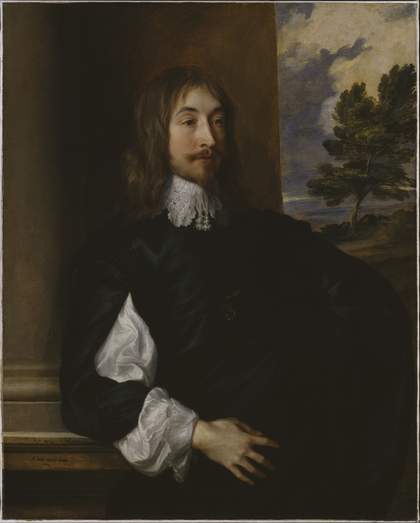
Fig.1
Sir Anthony Van Dyck (1599–1641)
Portrait of Sir William Killigrew 1638
Tate
T07896
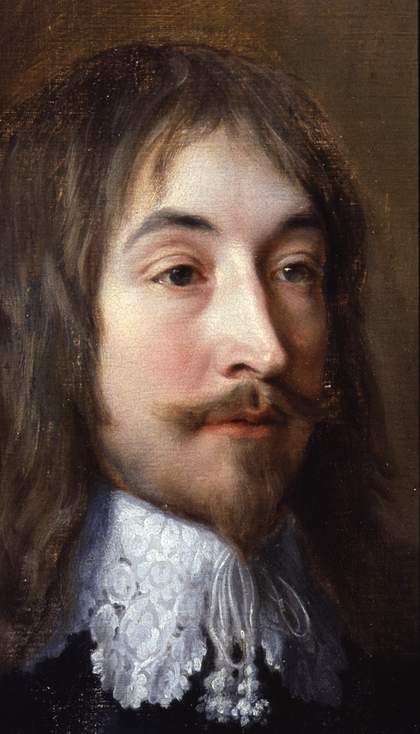
Fig.2
Detail of the face after removal of varnish and old retouches in 2003 and before restoration. Old abrasion of the paint is visible in the hair and the black costume
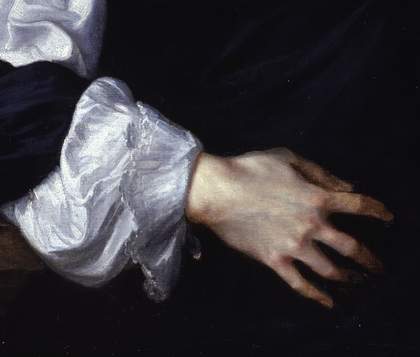
Fig.3
Detail of the right hand after removal of varnish and old retouches in 2003 and before restoration
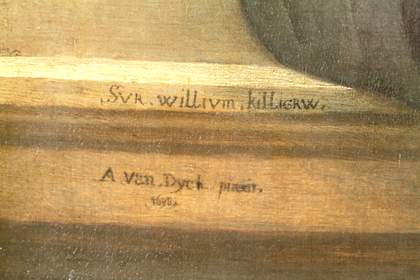
Fig.4
Detail of the inscription and signature
This painting is in oil paint on canvas measuring 1054 x 846 mm (figs.1–4). The plainly woven linen canvas is lined with animal glue onto another piece of linen canvas and is mounted with steel tacks on an adjustable pine stretcher. Lining and stretcher appear to date from the late nineteenth or early twentieth century.
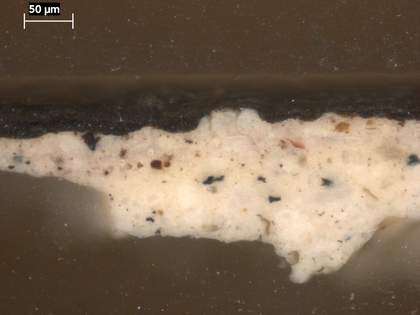
Fig.5
Cross-section through the black garment, photographed at x320 magnification. From the bottom upwards: two layers of opaque greyish beige ground; black paint of costume; later retouching (on left of sample); varnish layers
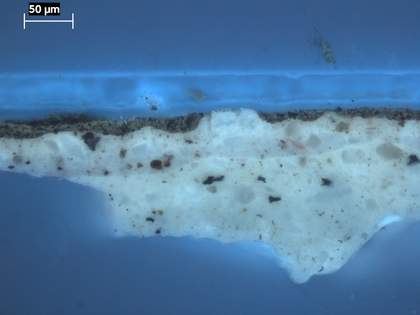
Fig.6
The same cross-section as in fig.5, photographed at x320 magnification in ultraviolet light. Note the fluorescence in the black paint, indicating it is oleoresinous
The ground is opaque light greyish beige colour, made up of two applications. The first is a thick layer (average thickness 400 μm) of white lead and chalk tinted with black, Cologne earth, and yellowish earth colours.1 The second, which fluoresces slightly differently when the cross-section is viewed in ultraviolet light, is a similar mixture with a greater proportion of Cologne earth; it is about 70 μm thick (figs.5–6).
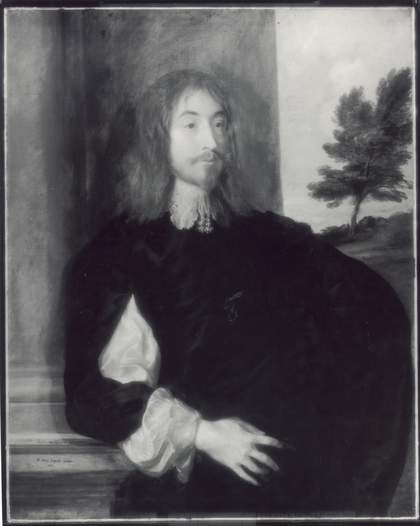
Fig.7
Infrared reflectogram of Portrait of Sir William Killgrew 1638, showing pentimenti
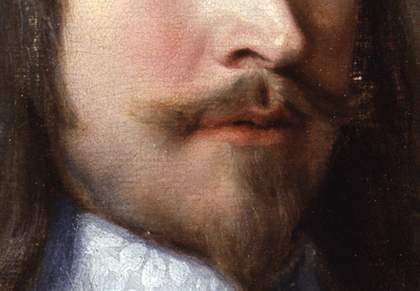
Fig.8
Detail of the face and hair of Portrait of Sir William Killigrew 1638, showing brown underpaint left visible as the shadow of his left cheek and in the hair on the left of the image
Hardly any preparatory drawing is visible with the unaided eye. The infrared reflectogram (fig.7) shows a rough lay-in of dark paint each side of his head, and a few brushed lines for the outline of the face and the top of his head; but they are minimal. Then the composition (including the face but not the cloak or the sky) was brushed in sketchily using shades of opaque brown paint. This paint was left visible here and there to act as dark shadows in the face, as strands in the hair and in the background (figs.1 and 8).
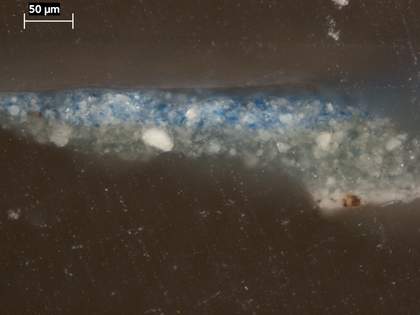
Fig.9
Cross-section through the sky, photographed at x320 magnification. From the bottom upwards: sliver of ground (on the right of the sample); underpainting of lead white mixed with smalt; final blue paint of lead white mixed with ultramarine
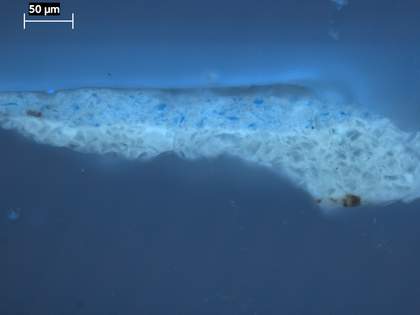
Fig.10
The same cross-section as in fig.8, photographed at x320 magnification in ultraviolet light. The glassy particles of smalt in the underpainting show up clearly
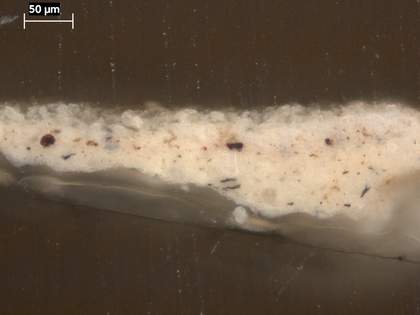
Fig.11
Cross-section through a cloud at the top edge, photographed at x320 magnification. From the bottom upwards: upper layer of ground; greyish paint of the cloud, containing lead white and smalt
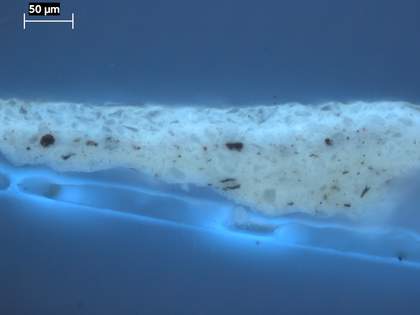
Fig.12
The same cross-section as in fig.11, photographed at x320 magnification in ultraviolet light
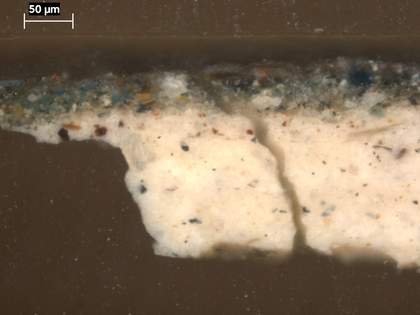
Fig.13
Cross-section through the foliage of the tree, photographed at x320 magnification. From the bottom upwards: double layer of ground; foliage paint made from varying mixtures of two or more blues, two or more yellows, red, black, white and translucent particles worked wet-in-wet
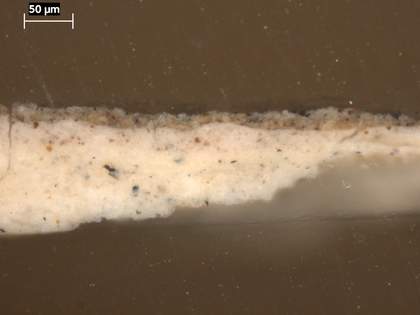
Fig.14
Cross-section through the pillar, photographed at x320 magnification. From the bottom upwards: double layer of ground; thin semi-opaque light brown underpaint of pillar; final sketchy bluish grey paint of pillar
The only area that displays substantial underpainting is the sky. Cross-sections and analysis reveal that it was first laid in with pale blue made from a mixture of lead white and smalt. This was then glazed over with brighter blue made from lead white and the expensive pigment ultramarine (figs.9–10). The clouds were painted directly onto the ground using mixtures of lead white and smalt, probably as part of the underpainting of the sky (figs.11–12). The binding medium for the sky is heat-bodied linseed oil.2 The column and green foliage have linseed oil as the binding medium. The greens of the foliage were mixed from ultramarine, black, Cologne earth, azurite, earth pigments and lead white (fig.13). The foliage of the tree was done with green mixtures worked together wet-in-wet onto the ground. The medium of the black costume is heat bodied linseed oil with a dash of pine resin; the principal pigments there are bone black, Cologne earth and chalk. The resinous component of the black costume has rendered it sensitive to past cleaning methods, resulting in a few areas of abrasion (fig.2). This damage was retouched with a very fine brush during treatment at Tate in 2003. The flesh paint has linseed oil as the medium but the white linen sleeve has mainly walnut oil, possible mixed with a small amount of linseed oil. Thin opaque bluish grey paint was sketched on top of the brown painted pillar to create the sense of volume (fig.14).
The artist made a few changes to the portrait during painting: Killigrew’s right arm was repositioned closer to his body, leaving a pentimento visible against the pillar at his side; the folds on his left shoulder were made more prominent; the fingers of his hand were first painted longer and straighter, and the thumb was fatter. These alterations are best seen in fig.7.
March 2022
